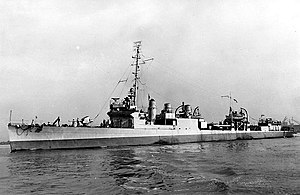 USS Blakeley in September 1942, after modernization
| |
| History | |
|---|---|
| Name | Blakeley |
| Namesake | Johnston Blakeley |
| Builder | William Cramp & Sons, Philadelphia |
| Cost | $1,448,367.50 (hull & machinery)[1] |
| Yard number | 465 |
| Laid down | 26 March 1918 |
| Launched | 19 September 1918 |
| Commissioned | 8 May 1919 |
| Decommissioned | 29 June 1922 |
| Recommissioned | 1932 |
| Decommissioned | 1937 |
| Recommissioned | 16 October 1939 |
| Decommissioned | 21 July 1945 |
| Stricken | 13 August 1945 |
| Fate | Sold for scrapping 30 November 1945 |
| General characteristics | |
| Class and type | Wickes-class destroyer |
| Displacement | 1,154 tons |
| Length | 314 ft 5 in (95.8 m) |
| Beam | 31 ft 8 in (9.7 m) |
| Draft | 9 ft 0 in (2.7 m) |
| Speed | 35 knots (65 km/h) |
| Complement | 122 officers and enlisted |
| Armament |
|
The second USS Blakeley (DD–150) was a Wickes-class destroyer in the United States Navy, named for Captain Johnston Blakeley.
Built in 1918, she saw patrol duty along the East Coast of the United States during the interwar era. Decommissioned for several years, she returned to duty at the outset of World War II. She spent much of the war on convoy patrol duty in the Caribbean Sea. On 25 May 1942, while on patrol, she was struck by a torpedo fired by the German submarine U-156, which blew off her forward 60 feet (18 m). Fitted with temporary measures, she steamed to Philadelphia Naval Yard where she was fitted with the forward section of sister ship USS Taylor. She spent much of the rest of the war on convoy patrol duty before being sold for scrap in 1945.
- ^ "Table 21 - Ships on Navy List June 30, 1919". Congressional Serial Set. U.S. Government Printing Office: 762. 1921.